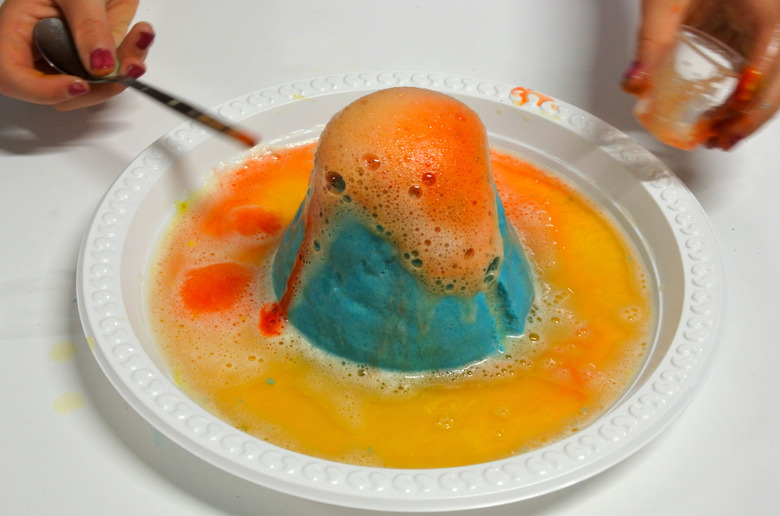Vinegar Experiment For Endothermic And Exothermic Reactions
Vinegar is one of the most useful chemicals you find around the house. It's basically a low-concentration solution, about 5 percent, of acetic acid, which has the chemical formula C2H4O2, sometimes written as CH3COOH to isolate the loosely bound hydrogen ion that makes it acidic. With a pH of around 2.4, acetic acid is fairly corrosive, but it's in such a low concentration in culinary vinegar that there's no problem pouring the vinegar on your fries or salad. Two lab experiments involving vinegar can demonstrate exothermic and endothermic reactions, which are those that give off and absorb heat respectively. One produces a foaming volcano that is cool in more ways than one while the other creates rusted metal and some heat.
TL;DR (Too Long; Didn't Read)
An exothermic reaction produces heat while an endothermic reaction consumes heat. Mix baking soda and vinegar to witness an endothermic reaction and soak steel wool in vinegar to witness an exothermic one.
The Foaming Volcano Experiment
The Foaming Volcano Experiment
Combine vinegar with baking soda (sodium bicarbonate) and measure the temperature, and you'll find that it drops about 4 degrees Celsius (7.2 degrees Fahrenheit) in about a minute. Although the temperature drop isn't exactly a result of the specific reaction between vinegar and baking soda, it wouldn't occur if you didn't combine them, so the overall process qualifies as an endothermic reaction. The combination also releases carbon dioxide gas, which bubbles up inside the mixture to create a foam that rises out of the container like lava from a volcano.
This reaction occurs in two steps. In the first, the acetic acid in vinegar reacts with sodium bicarbonate to produce sodium acetate and carbonic acid:
NaHCO3 + HC2H3O2 → NaC2H3O2 + H2CO3
Carbonic acid is unstable, and it quickly decomposes to form carbon dioxide and water:
H2CO3 → H2O + CO2
You can summarize the entire process with this equation:
NaHCO3 + HC2H3O2 → NaC2H3O2 + H2O + CO2
Stated in words, sodium bicarbonate plus acetic acid produces sodium acetate plus water plus carbon dioxide. The reaction consumes heat because energy is required to break the carbonic acid molecules into water and carbon dioxide.
The Rusting Steel Wool Experiment
The Rusting Steel Wool Experiment
An oxidation reaction is exothermic because it produces heat. Burning logs provide an extreme example of this. Because rusting is an oxidation reaction, it produces heat, although the heat usually dissipates too quickly to be noticeable. If you can get a steel wool pad to rust quickly, though, you can record the temperature rise. One way to do this is to soak a steel wool pad in vinegar to remove the protective coating from the steel fibers.
Place a fine steel wool pad in a glass container and pour in enough vinegar to cover it. Allow the pad to soak for about a minute, then remove it and place it in another container. Insert the end of a thermometer into the center of the pad and watch it for about 5 minutes. You'll see the temperature reading rise, and you may even notice fogginess on the side of the container if you use clear glass. Eventually the temperature will stop rising as the steel fibers get coated with a layer of rust, which blocks further oxidation.
What happened? The acetic acid in the vinegar dissolved the coating on the fibers of the steel wool pad, exposing the steel underneath to the atmosphere. The iron in the unprotected steel combined with oxygen to produce more iron oxide, and in the process, gave off heat. If you soak the pad again in vinegar and put it back in the dry container, you'll see the same temperature rise. You can repeat this experiment again and again until all the iron in the pad has rusted, although this would probably take several days.
Cite This Article
MLA
Deziel, Chris. "Vinegar Experiment For Endothermic And Exothermic Reactions" sciencing.com, https://www.sciencing.com/vinegar-experiment-endothermic-exothermic-reactions-18163/. 26 April 2018.
APA
Deziel, Chris. (2018, April 26). Vinegar Experiment For Endothermic And Exothermic Reactions. sciencing.com. Retrieved from https://www.sciencing.com/vinegar-experiment-endothermic-exothermic-reactions-18163/
Chicago
Deziel, Chris. Vinegar Experiment For Endothermic And Exothermic Reactions last modified March 24, 2022. https://www.sciencing.com/vinegar-experiment-endothermic-exothermic-reactions-18163/
